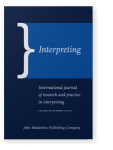Signed and spoken interaction at a distance
Interpreter practices to strive for progressivity at the beginning of calls via the Swedish video relay service
In video relay service (VRS), the interpreter is the only person who is directly linked to both users of the service, seeing the signing user of a videophone and hearing the speaking user of a telephone. The interaction is especially challenging at the beginning of the call. In this study, 25 authentic recorded calls from the Swedish VRS were analysed using conversation analysis. The aim of the study was to explore and describe in detail how the interpreters facilitate and strive for progression at the beginning of a VRS call. The study findings show how the interpreters provide information to the signing callers about their progress prior to the call being accepted, how the interpreters manage the spoken interaction with the called party on the telephone and how the interpreters connect the parties to each other. It is also shown how the interpreters work to make the deaf callers master a call. The results of the study enrich our current understanding of calls made via VRS.
Article outline
- 1.Introduction
- 2.Theoretical framework
- 3.The VRS process – A typology
- 4.Materials and methods
- 5.Results
- 5.1Information about the call progress prior to the called party answering
- 5.2Information about the service and the interaction to the called party
- 5.3The process of connecting the participants to each other
- 6.Conclusion
- Notes
-
References
References (31)
Bakhtin, M. M.
(
1981)
The dialogic imagination: Four essays by MM Bakhtin (
M. Holquist, Ed.;
C. Emerson &
M. Holquist, Trans.). Austin: University of Texas Press.

Bergman, B. & Nilsson, A.-L.
(
1999)
Teckenspråket. In
K. Hyltenstam (Ed.),
Sveriges sju inhemska språk: Ett minoritetsspråksperspektiv [
Sweden’s seven native languages: A minority language perspective]. Lund: Studentlitteratur, 329–339.

Brunson, J. L.
(
2011)
Video relay service interpreters: Intricacies of sign language access. Washington, DC: Gallaudet University Press.

Clark, H. H.
(
1996)
Using language. Cambridge: Cambridge University Press.


Drew, P. & Heritage, J.
(
1992)
Talk at work: Interaction in institutional settings. Cambridge: Cambridge University Press.

Goffman, E.
(
1974)
Frame analysis: An essay on the organization of experience. Cambridge: Harvard University Press.

Haualand, H. & Nilsson, A. L.
(
2019)
Working with active interpreters: A commentary about interpreting terminology and concepts.
International Journal of Interpreter Education 11 (2), 40–45.

Heritage, J.
(
1997)
Conversation analysis and institutional talk: analyzing data. In
D. Silverman (Ed.),
Qualitative research: Theory, method and practice. London: SAGE, 161–182.

Heritage, J.
(
2013)
Garfinkel and ethnomethodology. Cambridge: Polity Press.

Hutchby, I. & Wooffitt, R.
(
2008)
Conversation analysis. Cambridge: Polity Press.

Linell, P.
(
2009)
Rethinking language, mind, and world dialogically: Interactional and contextual theories of human sense-making. Charlotte, NC: Information Age Publishing.

Marks, A.
(
2018)
Hold the phone! Translation and Interpreting Studies 13 (1), 87–109.


Palmer, J. L., Reynolds, W. & Minor, R.
(
2012)
“You want what on your PIZZA!?”: Videophone and video-relay service as potential influences on the lexical standardization of American Sign Language.
Sign Language Studies 12 (3), 371–397.


Peterson, R.
(
2011)
Profession in pentimento. In
B. Nicodemus &
L. Swabey (Eds.),
Advances in interpreting research: Inquiry and action. Amsterdam: John Benjamins, 199–223.


PTS (Post-och telestyrelsen)
(
2015)
Upphandling Bildtelefoni 150215 [
Procurement Video Relay Service 150215].

Roy, C. B.
(
1989)
A sociolinguistic analysis of the interpreter’s role in the turn exchanges of an interpreted event. Doctoral dissertation, Gallaudet University.

Sacks, H., Schegloff, E. A. & Jefferson, G.
(
1974)
A simplest systematics for the organization of turn taking for conversation.
Language in Society 501, 696–735.

Schegloff, E. A.
(
2007)
Sequence organization in interaction: Volume 1: A primer in conversation analysis. Cambridge: Cambridge University Press.


Sidnell, J. & Stivers, T.
(
2013)
The handbook of conversation analysis. Chichester, UK: John Wiley & Sons.

Texttelefoni.se
(
2019)
Short information in English.
[URL] (accessed 21 August 2020).
Wadensjö, C.
(
1993)
The double role of a dialogue interpreter.
Perspectives: Studies in Translatology 1 (1), 105–121.


Wadensjö, C.
(
1998)
Interpreting as interaction. London: Longman.

Wadensjö, C.
(
2017)
Dialogue interpreting and the distribution of responsibility.
Hermes: Journal of Language and Communication in Business 8 (14), 111–129.

Warnicke, C
(
2017)
Tolkning vid förmedlade samtal via Bildtelefoni.net – Interaktion och gemensamt meningsskapande [
The interpreting of relayed calls through the service Bildtelefoni.net – Interaction and the joint construction of meaning]. Doctoral dissertation, Örebro University.

Warnicke, C.
(
2018a)
The co-creation of communicative projects within the Swedish Video Relay Service (VRS). In
J. Napier,
R. Skinner &
S. Braun (Eds.),
Here or there: Research on interpreting via video link. Washington, DC: Gallaudet University Press, 210–229.

Warnicke, C.
(
2018b)
Tolkning vid förmedlade samtal via Bildtelefoni. In
H. Haualand,
A.-L. Nilsson &
E. Raanes (Eds.),
Tolking – språkarbeid og profesjonsutøvelse [
Interpreting – language work and professional practice]. Oslo: Gyldendal akademisk, 143–157.

Warnicke, C. & Plejert, C.
(
2012)
Turn-organisation in mediated phone interaction using video relay service (VRS).
Journal of Pragmatics 44 (10), 1313–1334.


Warnicke, C. & Plejert, C.
Warnicke, C. & Plejert, C.
Warnicke, C. & Plejert, C.
in press).
The use of the text function in video relay service calls.
Text and Talk.
Cited by (1)
Cited by 1 other publications
Warnicke, Camilla & Mathias Broth
This list is based on CrossRef data as of 4 july 2024. Please note that it may not be complete. Sources presented here have been supplied by the respective publishers.
Any errors therein should be reported to them.
